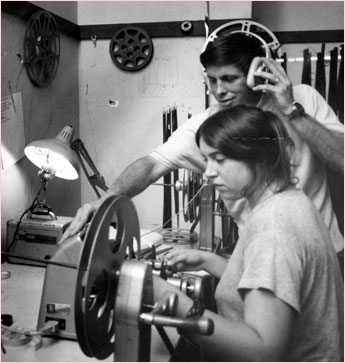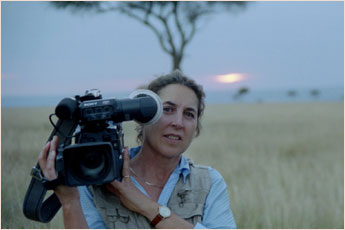Filmmaker's Statement 1978

I was at a meeting in central West Virginia on Feb. 26, 1972 when I first learned of the Buffalo Creek disaster. An hour or two had passed since the flood had swept through the Buffalo Creek community. Someone heard it on radio or TV --"A coal company dam has collapsed, thousands are affected, hundreds are missing and feared dead." The reaction to this news from the people in the room was similar--shock, horror, anger, outrage. The meeting was called to an end. Many people left for Buffalo Creek. I returned to Kentucky wondering what I could do.
Fearing that the Governor's committee set up to investigate the Buffalo Creek incident would not come up with a complete accounting for the events leading to the disaster, a group of concerned West Virginians formed the Citizens' Commission To Investigate The Buffalo Creek Disaster soon after the flood. The Citizen’s Commission scheduled hearings on Buffalo Creek and asked me and other members of Appalshop to film the proceedings. We had only a couple hundred feet of black & white film, a few blank videotapes, no money and little credit, but we felt it was very important to be there to document what went on.
We ended up spending several weeks in and around Buffalo Creek recording the hearings, videotaping interviews with survivors, and filming the destruction and cleanup operations (and in the process, having one crew member arrested and jailed for trespassing). I had never before experienced anything like the chaos, confusion, and despair that engulfed the Buffalo Creek community in the first weeks after the flood, and I hope I never do so again. It was incredibly difficult to have to ask survivors to talk about the disaster and to go out day after day to film such massive destruction. The experience of being on Buffalo Creek was physically and emotionally draining for all of us. I left the area feeling horribly depressed and wondering how we could use the film and video we had shot to tell such a difficult story, and where in the world we would get the money to do so.
I wrote a proposal and sent it to any foundation or group I thought might be interested in supporting the film. In the meantime, we returned to Buffalo Creek whenever we could and tried to come up with enough money and film stock or videotape to cover such events as the survivor's trip to the stockholder's meeting. And I read anything I could find that had something to do with Buffalo Creek: government reports, the Congressional Record, university-conducted studies, magazine and newspaper articles, industry and citizen group newsletters, etc. Finally, when I was just about ready to give up hope of ever getting the project off the ground, the Abelard Foundation gave Appalshop a small grant to produce the film.
The Buffalo Creek Flood: An Act of Man took a long time to complete. It was a complex story to tell and a painful one to have to deal with. The film would have been impossible to make without the film footage, photographs, and time donated to the project by people from throughout the region. We never really had enough money and that fact, together with the variety of film stocks and formats included in the film and my own inexperience, led to a film of poor technical quality. I hope that those viewing the film will be able to bear with it and see past these difficulties.
I made this film about the Buffalo Creek disaster because I believed the story of what happened and why needed to be told. As I learned more about the events preceding the tragedy and the responses of company and government officials afterwards, I became strongly convinced that the Buffalo Creek disaster was an outrageous example of an industry-wide attitude that places a greater value on profits and production than on the health and safety of coal miners, their families, and their communities.
Although the Buffalo Creek disaster affected more than those that mine coal, I do not believe it was an isolated incident. Rather, I see it as only one episode in an apparently unending series of mine-related disasters that periodically strike the coalfields. There have been over twenty U.S. mine disasters that have killed more than a hundred miners each. Added to these deaths are the more frequent mine fatalities that come in ones and twos. As of 1978, more than 120,000 men have died in the mines since the official death count began in 1839. There have been over 1.5 million serious mine-related accidents since 1930 alone. Even now in 1978, a miner is killed on the job on the average of once every other working day.
Yet, I do not believe it has to be this way. The technology is available to make mining safe for coal miners and the environment. Wales and West Germany are examples of other countries in which accident rates and environmental damages from mining have been greatly reduced for years. But the deaths in our mines and mining communities will not stop until the American coal industry is forced to take responsibility for its actions. Until that happens I believe there will be more Buffalo Creeks, more mine fatalities, and the people who live and work where the coal is mined will continue to pay its real costs.
I don't think this film will change the attitude or practice of the coal industry. I don't think a film can do anything of that magnitude. I only hope that the film will impart some knowledge, some understanding and insight, of the structure of power in Appalachia, and that it can provide a starting point from which to examine the rights and responsibilities of corporations, governments, and citizens in other coal mining communities and in our nation as a whole.
-Mimi Pickering
Filmmaker Biography
 Mimi Pickering has been making films and videotapes with Appalshop since 1971. Her documentaries often feature women as principle storytellers, focus on injustice and inequity, and explore the efforts of grassroots people to deal with community problems and work for change. The stories are told primarily through the voices and images of those most directly involved or affected by the issues. She is especially interested in the interplay and dynamics associated with combining traditional cultural aesthetics with social change agency.
Mimi Pickering has been making films and videotapes with Appalshop since 1971. Her documentaries often feature women as principle storytellers, focus on injustice and inequity, and explore the efforts of grassroots people to deal with community problems and work for change. The stories are told primarily through the voices and images of those most directly involved or affected by the issues. She is especially interested in the interplay and dynamics associated with combining traditional cultural aesthetics with social change agency.
Mimi is a recipient of a Guggenheim Fellowship and two Kentucky Arts Council Fellowships, as well as media production grants from the American Film Institute and the National Endowments for the Arts and Humanities. In addition to her production work, she directs Appalshop’s Community Media Initiative, which works with grassroots groups and public interest organizations to develop and implement communication strategies in support of social and economic justice organizing.
A native of California who attended Antioch College, Pickering had her first media experience as an intern in Charleston, WV, working for the West Virginia Black Lung Association, a group of disabled coal miners and their families who were fighting for just compensation for their black lung disease and to reform the United Mine Workers Union. While in West Virginia, she began work with Appalshop on a film production that became her first 16mm film, The Struggle of Coon Branch Mountain. In 1972 Pickering relocated to eastern Kentucky to continue her film training and media production at Appalshop, but she has continued her interest in West Virginia subjects throughout her career.
Pickering’s award-winning documentaries include The Buffalo Creek Flood: An Act of Man (1975), which was one of 25 "culturally, historically, or aesthetically" significant motion pictures named by the Librarian of Congress to the National Film Registry in 2005. Described by Newsweek as "a powerful piece of muckraking on film," the documentary was a Silver Plaque winner at the Chicago International Film Festival. Filmed 10 years after the disaster, Buffalo Creek Revisited looks at the efforts of Buffalo Creek survivors to rebuild the physical and emotional community shattered by the flood.
Other work includes Chemical Valley (1991), a documentary produced with Anne Lewis about issues of environmental justice in the Kanawha Valley of West Virginia. Chemical Valley was broadcast nationally on PBS as part of the P.O.V. series. The program was screened at the U.S. Environmental Film Festival, the Earth/Peace Film Festival, the San Francisco International Film Festival and the American Film and Video Festival, where it won a Blue Ribbon.
Dreadful Memories (1988) explores the legacy of Sarah Ogan Gunning, a singer and songwriter from eastern Kentucky whose hauntingly beautiful ballads about the lives of working people were written from the experiences that radicalized her in the strike torn coalfields of the 1930s. Dreadful Memories was screened nationally as part of The Independents' "Played in the U.S.A.," a series running on The Learning Channel and PBS stations. It also was broadcast in Texas as part of The Territory, and on WNET’s Independent Focus.
In 2001, Pickering completed Hazel Dickens: It's Hard to Tell the Singer From the Song, a 60 minute portrait of this West Virginia singer/songwriter and 2001 National Heritage Award winner described by the Washington Post as "a living legend of American music, a national treasure." The Oral History Review called the film “a powerful tale told by one of Appalachia’s most reverent filmmakers working today.”
Copyright © Appalshop | Contact Mimi Pickering